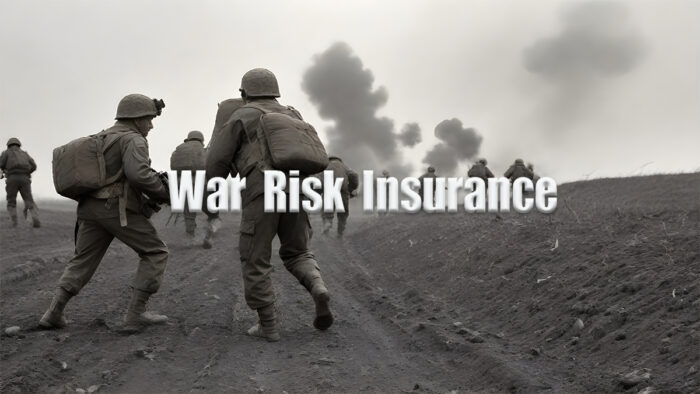War risk insurance serves as a protective financial measure, shielding policyholders from potential losses stemming from various tumultuous events like invasions, insurrections, riots, strikes, revolutions, military coups, and acts of terrorism.

This specialized insurance coverage is distinct from common policies like auto, homeowners, renters, commercial property, fire, and life insurance, which typically incorporate exclusions related to war risks.
These exclusions mean that standard insurance policies do not cover damages arising from war-related incidents, prompting the option for a supplementary war risk insurance rider to bridge this gap in protection.
It is often separate from standard insurance due to the uncertainties and increased risks of war-related situations. It’s structured as a standalone policy to address these specific concerns.
This separation is necessitated by the exclusion of war risk coverage in standard policies. Hence, it reflects the challenges insurers face in accurately assessing and pricing the potential damages linked to war events.
Particularly relevant for businesses and individuals operating in regions deemed high-risk due to geopolitical instability or conflict, war risk insurance emerges as a vital safeguard against unforeseen financial repercussions resulting from war, invasions, insurrections, riots, strikes, and acts of terrorism.
How Does War Risk Insurance Work?
Understanding war risk insurance entails comprehending coverage meant to protect against losses from acts of war. It includes events such as invasions, insurrections, rebellions, and hijackings.
This specialized insurance, commonly utilized in the shipping and aviation sectors, differs from standard policies by not incorporating a broad war exclusion clause. Typically, war risk insurance comprises two key components: war risk liability, safeguarding individuals and items within the craft, and war risk hull, protecting the craft itself.
Premiums for war risk insurance are influenced by the perceived stability of the countries the vessel will traverse. Notably, private war risk insurance policies for aircraft faced temporary cancellations after the September 11, 2001 attacks, later reinstated with reduced indemnities. The complexity of this insurance policy necessitates a nuanced understanding to navigate its coverage nuances effectively.
Why War is Typically Excluded from Standard Insurance Policies
Standard insurance policies typically exclude war as a covered risk because of the unpredictable nature of war-related damage. This makes it difficult for insurance companies to accurately anticipate and price premiums.
Insurers typically set rates and coverage based on identifiable risks. And the extensive variability in damages caused by war complicates this process significantly.
Among traditional insurance types, only workers’ compensation provides coverage for injuries or fatalities resulting from acts of war.
Qualified employees injured or killed in war-related incidents while working abroad are protected by the War Hazards Compensation Act. This act ensures their safeguarding in such circumstances.
This legislation ensures that insurance companies are reimbursed for workers’ compensation benefits disbursed for losses linked to the war.
What Does War Risk Insurance Cover?
War risk insurance provides coverage for losses resulting from events like war, invasions, insurrections, riots, strikes, and terrorism.
It covers perils such as kidnappings and ransom, sabotage, emergency evacuation, worker injury, long-term disability, and loss or damage of property and cargo.
Some policies may cover event cancellations due to war, and there are options that include acts of terrorism within the coverage.
The aviation and maritime sectors may have specialized war insurance options to address their unique needs. These policies compensate for losses such as vessel seizures or detention resulting from war activities.
It can cover physical damage to property, loss of income, and liability claims arising from acts of war, including events involving nuclear weapons or devices, civil unrest, cyber-attacks, and war in specific regions.
What It Doesn’t Cover
War risk insurance policies commonly exclude coverage for losses or damages caused by acts of piracy.
Cyberattacks are often excluded from this insurance coverage due to their unpredictable nature and potential for significant damage.
Specific regions or countries where war or conflict is more likely may be excluded from war risk insurance coverage, such as the Middle East or Africa.
It may exclude coverage for civil unrest, including riots, protests, and civil disobedience, due to their unpredictable and damaging nature.
Exclusions for events involving the use of nuclear weapons or devices, such as explosions, radiation exposure, and fallout, are common in war risk insurance policies due to the high potential damage and risk involved.
FAQs
What is the war risk clause in insurance policies?
The war risk clause in insurance policies is a provision that outlines the coverage and exclusions related to losses or damages resulting from war-related events. It specifies the extent to which an insurance policy covers risks associated with acts of war, invasions, insurrections, terrorism, and other war-related perils.
What is the meaning of war risk?
War risk refers to the potential exposure to financial losses or damages arising from acts of war, military conflicts, civil unrest, terrorism, and related events. It encompasses the uncertainties and liabilities associated with war-related perils that may impact individuals, businesses, or assets.
What type of risk is war?
War is classified as a catastrophic or high-severity risk due to its unpredictable nature, widespread impact, and potential for significant losses. It is considered an extreme form of risk that can result in extensive damage, disruption, and financial implications for insured parties.
What is an example of a war risk?
An example of a war risk scenario could involve a shipping company operating in a region prone to political instability and armed conflict. If a war breaks out in that area, leading to the seizure or destruction of the company’s vessels, cargo, or infrastructure, the losses incurred would be considered a war risk. This could include damages from bombings, hijackings, or military actions impacting the company’s operations and assets.



